Personal computers, including desktops, notebooks, tablets, thin clients and workstations, are currently covered by the Ecodesign Regulation (EU) 617/2013.
Scope
The following table shows some examples of products in scope and out of scope in the Ecodesign Regulation:
| In Scope | Out of Scope |
|---|---|
|
|
Check the complete list in the Regulation (EU) 617/2013.
Enterprise servers and data storage products are covered by the Ecodesign Regulation (EU) 2019/424. Computer monitors are covered by the Ecodesign Regulation (EU) 2019/2021 and Labelling Regulation (EU) 2019/2013.
Ecodesign Requirements
Computers and small-scale servers sold in the EU are subject to Ecodesign rules, as outlined in Regulation (EU) No 617/2013. The requirements cap estimated annual energy consumption based on a product's average use pattern considering a mix of time spent in idle, sleep or off state. They also include requirements for the efficiency of the internal power supply and power management.
The current Ecodesign regulation is obsolete and under review. The process is expected to lead to both Ecodesign and labelling requirements for energy efficiency. The approach being investigated uses the execution of a set of "worklets" simulating a mix of two types of real-use conditions:
- for for the average user (office or home-office use performing text editing, sorting rows in a spreadsheet, browsing, playing a video, etc)
- for professional users, executing number-crunching computations or 3D modelling, virtual reality or artificial intelligence and similar intensive scenarios or gaming
A new efficiency metric has been developed to assess the performance to energy-use ratio and will be used for the energy-efficiency labelling scale.
The envisaged regulations would also cover reliability and reparability aspects. On average, over half of the energy over the entire product life cycle is used for material extraction and computer fabrication, therefore by extending the product lifetime, energy savings are sought over the whole lifecycle.
Facts & Figures
This graphic shows the estimated sales, stock, energy consumption (primary, electric or fuel), greenhouse gas emissions, consumer expenses and business revenues for years 2010 and 2030. The estimated values inside the graph bars are those from the scenario including the effects of Ecodesign measures.
The difference with the business as usual (BAU) scenario without these estimated measures is shown next to the graph bar. These figures indicate the estimated savings obtained due to the measures.
Product: Personal Computers Measures: Regulation (EU) No.617/2013 |
|---|
| The striped lines in the charts show the 'Effect of the Regulations' |
SALES (x1000 units) 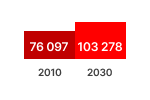 | STOCK (x1000 units) 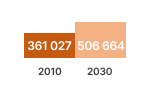 | Electricity (TWh/a) 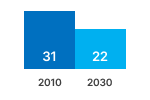 |
GHG-EMISSION 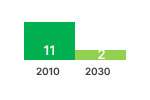 | CONSUMER EXPENSES 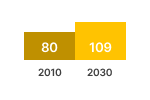 | REVENUES 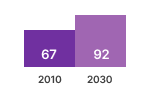 |
Source: estimations from the Ecodesign Impact Accounting Overview Report 2024
In 1990, roughly marking the start of public internet use in Europe, ‘only’ 55 million personal computers (PCs) were in use in the EU27, of which 97% were desktops.
In 2020, this increased to 349 million PCs, of which 24% were desktops, and 72% notebooks (laptops) or tablet computers. Approximately two-thirds were used in households. In 2020, 28% of the households had a desktop computer, and 89% a notebook or tablet computer.
Workstations or thin clients, mainly used in offices, were 4% of the total.
The energy efficiency measures for PCs, from the 2013 Ecodesign regulation and the EU-USA ENERGY STAR until 2018, regard the off-, sleep- and idle-modes. Energy consumption in active modes was too uncertain to be regulated.
For the regulated modes, the annual energy consumption per PC dropped by over 65% in the 1990-2000 period, notwithstanding an increase in performance. This was due to technical progress and market forces, not to the measures.
In 2020, PCs in the EU27 consumed 19 TWh of electricity (in off-, sleep- and idle-modes), down from 31 TWh in 2010. PCs in the average household consumed 57 kWh in 2020. Rough estimates indicate that the 2020 values could increase by 150% when including active modes.
For PCs, the minimum requirements of the 2013 Ecodesign regulation were based on the 2007 preparatory study, and for this fast-moving sector were not effective when introduced in 2013. Hence, there are no energy savings due to the measures.
In 2020, EU27 users spent 70 bn euros for PCs, of which 66 bn euros for acquisition and 4 bn euros for energy costs (excluding active modes). Expenditure per household in 2020 was € 241.
There are no cost savings due to the measures.
Expected Savings
Sales of desktop computers peaked between 1990 and the early 2000s. After this laptops gained in market share. Since the average energy consumption of laptops is approximately a third of a desktop, the total electricity consumption is decreasing. A similar situation occurs in the 2010-2020 period, where laptops are replaced by tablets or slates, again reducing the average electricity consumption to a third. Meanwhile, notebook technologies also find their way into desktops, leading to more energy efficient desktops as well. This explains the decrease in electricity consumption up to 2020, even without the effects of Ecodesign measures included.
Total EU27 Electricity Consumption of Personal Computers
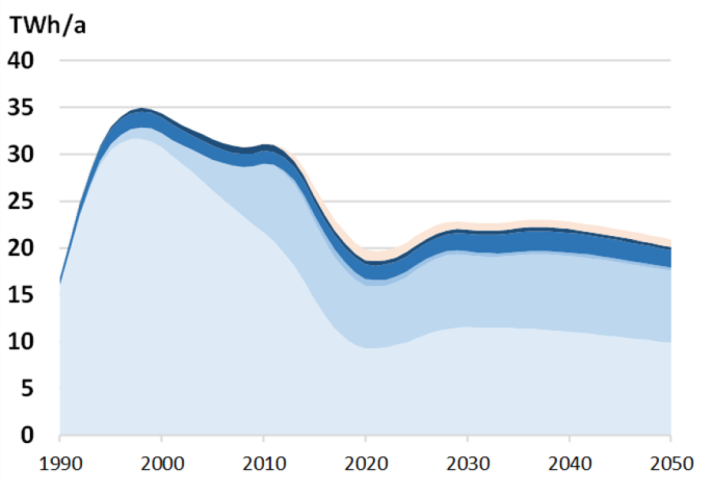

Efficiency
The energy-efficiency of PCs has improved spectacularly as shown in the graph on annual electricity consumption per device.
Despite a tenfold growth in numbers since 1990, the total EU27 electricity consumption in 2020 (19 TWh/a) is barely 11% more than in 1990 (17 TWh/a). For 2030 an additional rise of +2 TWh/a electricity consumption is foreseen for a stock growing with +40%.
Average Annual Electricity Consumption of Personal Computers per Unit


Source: estimations from the Ecodesign Impact Accounting Overview Report 2024

Suppliers
The Computer Ecodesign Regulation is under review. Please consult the Policy section for updates.

Policy
Regulations in force
Regulation (EU) No 617/2013 of 26 June 2013 implementing Directive 2009/125/EC of the European Parliament and of the Council with regard to Ecodesign requirements for computers and computer servers. Text with EEA relevance.
Relevant standards
Standardisation mandate M/545 on methods of measurement for compliance checking (repealed).
Ongoing legislative work
The Computer Ecodesign Regulation is under review. Please check the state of play of the ongoing review process in the Register of delegated and implementing acts. Public Consultations and Feedback are made available in the Have your say portal.
A proposal for a new Energy Labelling Regulation is under preparation. Please check the state of play of the ongoing review process in the Register of delegated and implementing acts. Public Consultations and Feedback are made available in the Have your say portal.

